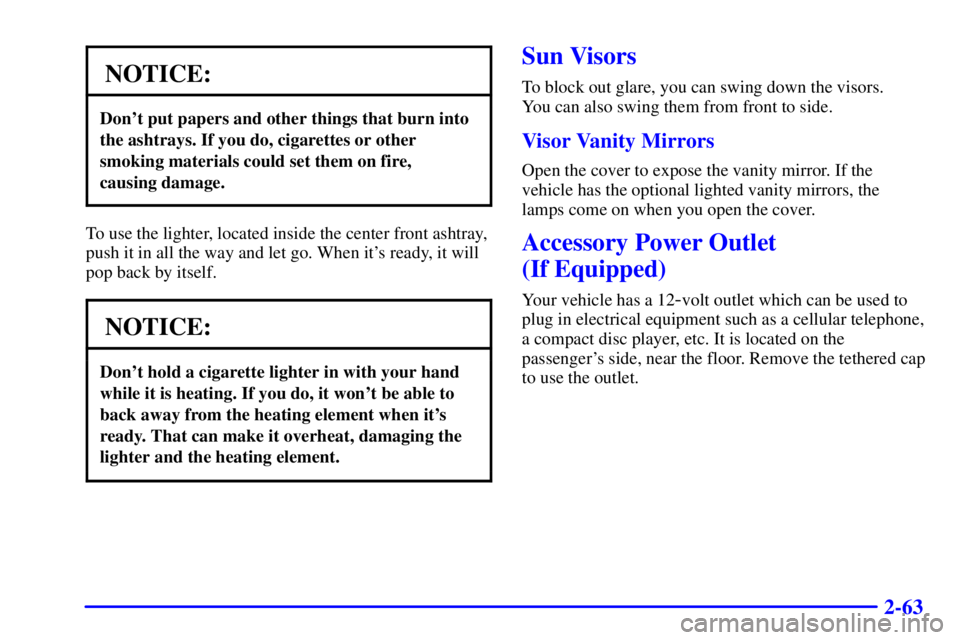Page 4 of 376
ii
Table of Contents
Keys and Door Locks
Keyless Entry System (If Equipped)
Remote Trunk Release (If Equipped)
Automatic Transaxle
Parking Brake
Power Windows
Tilt Wheel
Turn Signal/Multifunction Lever
Windshield Wipers
Cruise Control (If Equipped)
Interior and Exterior Lamps
Mirrors
Storage Compartments
Convenience Net (If Equipped)
Accessory Power Outlet (If Equipped)
OnStar® System (If Equipped)
Sunroof (If Equipped)
Instrument Panel, Warning Lights and Gages
Head-Up Display (Option)
Driver Information Center (If Equipped) Seats and Seat Controls
Safety BeltsSupplemental Restraint System (SRS)
Child Restraints
Section
1
Section
2
Seats and Restraint Systems
Features and Controls
Page 69 of 376

2-
2-1
Section 2 Features and Controls
Here you can learn about the many standard and optional features on your vehicle, and information on starting,
shifting and braking. Also explained are the instrument panel and the warning systems that tell you if everything is
working properly
-- and what to do if you have a problem.
2
-2 Keys
2
-4 Door Locks
2
-7 Keyless Entry System (If Equipped)
2
-12 Multifunction Alarm Locks and
Lighting Choices
2
-23 Trunk
2
-24 Theft
2
-25 Content Theft-Deterrent (If Equipped)
2
-27 PASS-Key� III
2
-29 New Vehicle ªBreak-Inº
2
-29 Ignition Positions
2
-30 Starting Your Engine
2
-33 Engine Coolant Heater (If Equipped)
2
-34 Automatic Transaxle Operation
2
-39 Parking Brake
2
-40 Shifting Into PARK (P)
2
-42 Shifting Out of PARK (P)2
-43 Parking Over Things That Burn
2
-44 Engine Exhaust
2
-44 Running Your Engine While You're Parked
2
-45 Power Windows
2
-47 Turn Signal/Multifunction Lever
2
-52 Exterior Lamps
2
-54 Interior Lamps
2
-57 Mirrors
2
-59 Storage Compartments
2
-64 OnStar� System (If Equipped)
2
-65 Sunroof (If Equipped)
2
-66 The Instrument Panel -- Your
Information System
2
-70 Warning Lights, Gages and Indicators
2
-84 Head-Up Display (Option)
2
-88 Driver Information Center (DIC)
(If Equipped)
2
-90 Trip Computer (If Equipped)
Page 125 of 376

2-57 Battery Saver
The vehicle has a feature to help prevent you from
draining the battery in case you accidentally leave the
interior, trunk or underhood lamps on. If you leave any
of these lamps on while the ignition is in LOCK or OFF,
they will automatically turn off after 10 minutes.
The lamps won't come back on again until you do
one of the following:
�Turn the ignition to RUN or ACCESSORY.
�Turn the interior lamp thumbwheel completely to the
right, then back slightly to the left.
�Open (or close and reopen) a door that is closed.
If the vehicle has less than 15 miles (25 km) on the
odometer, the battery saver will turn off the lamps after
only three minutes.
Mirrors
Adjust all the mirrors so you can see clearly when you
are sitting in a comfortable driving position.
Inside Day/Night Rearview Mirror
To reduce glare from lamps behind you, pull the lever
located in the center of the bottom of the mirror toward
you to the night position. To return the mirror back to
the day position, push the lever away from you.
Page 126 of 376
2-58 Electrochromic Day/Night Rearview Mirror
(If Equipped)
The vehicle may have an electrochromic day/night
rearview mirror. Push the button on the bottom of the
mirror to turn this feature on. The mirror will darken
gradually to reduce glare from headlamps behind you.
This may take a few moments.One photocell on the front of the mirror senses when it
is becoming dark outside. Another photocell, facing
rearward, senses headlamps behind you. To turn the
electrochromic feature off, press the button on the
bottom of the mirror again.
To keep the photocells operating well, occasionally
clean them with a cotton swab and glass cleaner.
Power Outside Mirrors
The power mirror control
is located near the driver's
window, on the armrest.
Turn the control
counterclockwise to adjust
the left mirror or clockwise
to adjust the right mirror.
Then move the control in
the direction you want to
move the mirror.
Page 127 of 376
2-59 Convex Outside Mirror
Your passenger's side mirror is convex. A convex
mirror's surface is curved so you can see more from the
driver's seat.
CAUTION:
A convex mirror can make things (like other
vehicles) look farther away than they really are.
If you cut too sharply into the right lane, you
could hit a vehicle on your right. Check your
inside mirror or glance over your shoulder before
changing lanes.
Storage Compartments
Glove Box
Use the master key to lock and unlock the glove box.
To open, lift the right side of the latch.
Overhead Console (Option)
The optional overhead console has reading lamps and
storage compartments (including one for your garage
door opener and one for sunglasses). These features are
explained on the following pages.
Page 131 of 376

2-63
NOTICE:
Don't put papers and other things that burn into
the ashtrays. If you do, cigarettes or other
smoking materials could set them on fire,
causing damage.
To use the lighter, located inside the center front ashtray,
push it in all the way and let go. When it's ready, it will
pop back by itself.
NOTICE:
Don't hold a cigarette lighter in with your hand
while it is heating. If you do, it won't be able to
back away from the heating element when it's
ready. That can make it overheat, damaging the
lighter and the heating element.
Sun Visors
To block out glare, you can swing down the visors.
You can also swing them from front to side.
Visor Vanity Mirrors
Open the cover to expose the vanity mirror. If the
vehicle has the optional lighted vanity mirrors, the
lamps come on when you open the cover.
Accessory Power Outlet
(If Equipped)
Your vehicle has a 12-volt outlet which can be used to
plug in electrical equipment such as a cellular telephone,
a compact disc player, etc. It is located on the
passenger's side, near the floor. Remove the tethered cap
to use the outlet.
Page 206 of 376

4-15
�Do not get too close to the vehicle you want to pass
while you're awaiting an opportunity. For one thing,
following too closely reduces your area of vision,
especially if you're following a larger vehicle.
Also, you won't have adequate space if the vehicle
ahead suddenly slows or stops. Keep back a
reasonable distance.
�When it looks like a chance to pass is coming up,
start to accelerate but stay in the right lane and don't
get too close. Time your move so you will be
increasing speed as the time comes to move into the
other lane. If the way is clear to pass, you will have a
ªrunning startº that more than makes up for the
distance you would lose by dropping back. And if
something happens to cause you to cancel your pass,
you need only slow down and drop back again and
wait for another opportunity.
�If other cars are lined up to pass a slow vehicle, wait
your turn. But take care that someone isn't trying to
pass you as you pull out to pass the slow vehicle.
Remember to glance over your shoulder and check
the blind spot.�Check your mirrors, glance over your shoulder, and
start your left lane change signal before moving out
of the right lane to pass. When you are far enough
ahead of the passed vehicle to see its front in your
inside mirror, activate your right lane change signal
and move back into the right lane. (Remember that
your right outside mirror is convex. The vehicle you
just passed may seem to be farther away from you
than it really is.)
�Try not to pass more than one vehicle at a time on
two
-lane roads. Reconsider before passing the
next vehicle.
�Don't overtake a slowly moving vehicle too rapidly.
Even though the brake lamps are not flashing, it may
be slowing down or starting to turn.
�If you're being passed, make it easy for the
following driver to get ahead of you. Perhaps you
can ease a little to the right.
Page 207 of 376

4-16
Loss of Control
Let's review what driving experts say about what
happens when the three control systems (brakes, steering
and acceleration) don't have enough friction where the
tires meet the road to do what the driver has asked.
In any emergency, don't give up. Keep trying to
steer and constantly seek an escape route or area of
less danger.
Skidding
In a skid, a driver can lose control of the vehicle.
Defensive drivers avoid most skids by taking reasonable
care suited to existing conditions, and by not
ªoverdrivingº those conditions. But skids are
always possible.
The three types of skids correspond to your vehicle's
three control systems. In the braking skid, your wheels
aren't rolling. In the steering or cornering skid, too
much speed or steering in a curve causes tires to slip and
lose cornering force. And in the acceleration skid, too
much throttle causes the driving wheels to spin.
A cornering skid is best handled by easing your foot off
the accelerator pedal.If you do not have the Enhanced Traction System or the
Traction Control System, or if the system is off, then an
acceleration skid is also best handled by easing your
foot off the accelerator pedal.
If your vehicle starts to slide, ease your foot off the
accelerator pedal and quickly steer the way you want the
vehicle to go. If you start steering quickly enough, your
vehicle may straighten out. Always be ready for a
second skid if it occurs.
Of course, traction is reduced when water, snow, ice,
gravel or other material is on the road. For safety, you'll
want to slow down and adjust your driving to these
conditions. It is important to slow down on slippery
surfaces because stopping distance will be longer and
vehicle control more limited.
While driving on a surface with reduced traction, try
your best to avoid sudden steering, acceleration or
braking (including engine braking by shifting to a lower
gear). Any sudden changes could cause the tires to slide.
You may not realize the surface is slippery until your
vehicle is skidding. Learn to recognize warning
clues
-- such as enough water, ice or packed snow on
the road to make a ªmirrored surfaceº
-- and slow
down when you have any doubt.
Remember: Any anti
-lock brake system (ABS) helps
avoid only the braking skid.